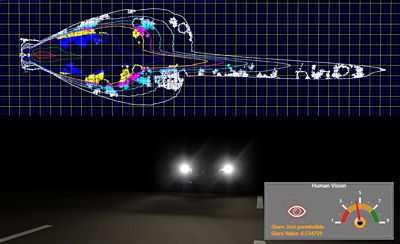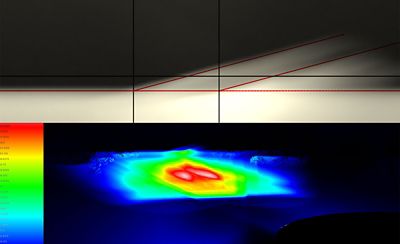什么是自适应前照灯?
自适应前照灯利用多种技术组合来控制前照灯的方向、距离、亮度和车灯光型,以便在夜间提供更好的照明,同时最大限度地减少对其他车辆驾驶员造成的眩光。
两种常见的自适应前照灯系统类型,分别是自适应驾驶光束(ADB)系统和自适应前部照明系统(AFS)。自适应前照灯使用摄像头、雷达、激光雷达和光传感器,并结合天气、速度和转向信息,来主动应对不断变化的驾驶环境。
大多数自适应前照灯系统,可以归类为以下三种前照灯技术之一:
- 自动远光灯:当车辆前方没有其他车辆时打开远光灯,检测到其他车辆时切换回近光灯
- 弯道自适应前照灯:一种AFS系统,其可将一个或两个前照灯光束调整到转弯处,以便驾驶员可以更清楚地看到转弯处
- 自适应驾驶光束前照灯(ADB):调整驾驶光束不同区域的亮度,在未被占用的区域提供更多光线,在已被占用的区域减少光线
如今,大多数新车都配备了自适应远光灯或在转弯时大灯会自动转动的系统,采用光型调节技术的自适应驾驶光束前照灯也已在欧洲投入使用。美国新采用的国家公路交通安全管理局(NHTSA)标准已促使向美国市场销售产品的汽车制造商和供应商展开竞争,以开发符合新标准的产品。特别是FMVSS 108标准,其定义了仿真在ADB虚拟认证中的应用。
自适应前照灯的优势
大量数据显示,车辆与车辆之间以及车辆与行人之间的事故在夜间更为普遍,高达76%的涉及行人的致命碰撞事故发生在夜间。在所有交通事故记录中,12-15%都将迎面车辆的前照灯眩光列为一个事故因素。新型系统使驾驶员能够观察到更多情况并看到更远的道路,因此产生了积极影响,将行人与车辆的碰撞事故减少了多达23%。
这些数字,促使特斯拉、奥迪、宝马、福特、本田、梅赛德斯-奔驰、保时捷和丰田等汽车制造商开始探索全新的自适应照明技术。目前,这项技术并不是强制性的。不过,汽车制造商认为,各种形式的自适应前照灯可为消费者提供额外的安全功能,并在竞争激烈的市场中使其新车脱颖而出。
自适应前照灯的工作原理是什么?
如今,前照灯不再是由反射器中的一个近光灯和一个远光灯组成(配有手动开关来单独或同时打开或关闭),现代的前照灯是具有软件、复杂组件和车辆网络接口的先进系统。
为了提供自动远光灯、转弯照明和光型调节功能,每个制造商都有自己的配置和系统,但其中大多数组件可以分为以下几种类别。
传感器
各种传感器可收集信息,包括转向、车速、照明条件、天气、驾驶条件、道路宽度以及其他车辆的位置。新款车型现在还使用GPS位置和地图数据来主动向系统提供信息。传感器可以像车辆上已安装的光学或热/红外摄像头以及雷达、激光雷达或声纳测距设备一样复杂,它们已经在车辆上用于支持其他安全系统。这些设备可提供物体的尺寸、位置和速度信息,尤其是迎面而来的汽车的信息。较简单的传感器可提供方向盘的位置、环境照明条件和天气信息。ADB系统的准确运行取决于在传感器和ECU之间建立精确的反馈回路,以帮助执行必要的操作。
软件和电子设备
来自传感器的信息被传输到自适应前照灯控制硬件,以便驱动系统的控制软件能够适应当前情况。电子设备可以集成到前照灯总成、单独的控制单元或车辆控制计算机中。除了控制功能外,软件和电子设备还可为前照灯总成提供具有适当电压、脉宽调制(PWM)和质量的电源。
前照灯总成
自适应前照灯系统的主体由前照灯总成本身组成。控制系统会将旋转方式、每个光源的亮度以及自适应驾驶光束的亮区和暗区等信息告知该总成。最重要的是,前照灯总成包含光学光路径。工程师利用广泛的仿真和原型设计来优化总成的光学特性。
以下是对前照灯总成中每个子组件的描述:
外壳
前照灯总成被封装在一个与环境隔离的外壳模块中,集成在车辆前部,可以作为一个整体进行更换。
透镜和反射器
每个光源的光束形状和质量,都是由外壳组件前部内置的光学透镜或光源后面的反射器来控制的。有些反射器是自适应的,可以根据自适应系统的指示进行调整或倾斜。
致动器
许多自适应前照灯系统使用步进电机或致动器来移动光路径中的组件或旋转整个总成的指向方向,从而改变前照灯光束。前照灯总成中的致动器需要足够稳健,以承受车辆冲击和振动、极端天气条件以及满足长时间的日常使用需求。
光源
光源是任何自适应前照灯系统的核心。在一些新车型中,光源由一个或多个卤素灯泡、氙气投影灯、LED灯、LED矩阵或激光器组成。光源的类型决定了其成本、光色和强度。每种光源类型都有其优缺点,但LED灯或矩阵组件凭借其控制和亮度优势,成为了当前首选的光源。
光型调节
为了实现所需的光型(光束图案),人们会使用多种技术来调节光束中不同区域的亮度,通过选择性地产生或掩蔽光线,来塑造目标光型。下面是几种最常见的方法:
- 掩蔽:最简单的方法是使用一块有色材料来遮挡光束的顶部,从而在检测到迎面车辆时关闭远光灯,遮蔽特定车辆,或阻挡光线照射到道路一侧。也可以将固定式LCD滤波器放置在光源和透镜之间的光路径中,以选择性地掩蔽光束。
- 微镜:这些光型调节系统的工作原理与数字光处理(DLP)投影仪类似,其中向后的光源将光投射到微镜组件上,然后微镜组件将具有所需亮度图案的光反射出去,通过透镜投射到前方。这种方法不仅可以提供选择性遮蔽,还可用于将信息投射到车辆前方的路面上。
- LED矩阵:最常见的光型调节方法,通常称为自适应LED前照灯,它采用的是排列成矩阵的小型明亮LED灯阵列。其中,每个LED都像是一个像素,可以根据需要调亮或调暗。
热管理系统
无论采用哪种光源,产生强光都会带来大量热量。然而,LED等新型光源产生的红外能量比旧系统产生的红外能量更少,而旧系统以前可以利用这种能量来融化透镜上的雪和冰。因此,热管理解决方案是强大的自适应前照灯系统的一个重要部分,其能让光源、电源系统和电子设备保持冷却,同时将多余热量转移到透镜组件。
仿真如何助力自适应前照灯设计
无论是对于简单的远光辅助系统,还是最新的AFS,设计自适应前照灯系统的工程师都需要应对以下几项重大挑战:
- 车辆冲击和振动
- 封装
- 响应时间
- 眩光
- 光源位置与光型
- 热管理
- 热循环
- 系统集成
- 安全标准
- 性能优化
- 成本降低
- 系统验证/夜间驾驶测试
大多数汽车制造商已经将由仿真技术驱动的产品开发集成到设计流程中,以克服这些挑战,并优化不断发展的自适应前照灯系统。仿真在自适应前灯系统中最常见的应用方式如下:
组件光学设计与优化
利用仿真对前照灯总成中的光源、透镜、有源和无源反射器进行建模。许多前照灯专家都使用Ansys Zemax OpticStudio软件来优化每个组件和光学装配体。该工具的参数化特性、直观的用户界面和快速求解时间,使用户可以轻松查看自适应系统可能遇到的各种光学情况。

可定制的等照度线和区域(上)以及不适眩光仿真(下)
虚拟光学性能可视化
完成组件的光学设计后,工程师就可以将生成的光束放入系统级建模工具(如Ansys Speos软件)中,以将车辆驾驶员沿道路行驶时所看到的情况可视化。在构建原型之前,就可以对每种可能的驾驶条件进行仿真,以查看系统的性能表现。更进一步,利用Ansys AVxcelerate Headlamp软件等实时仿真工具,可以对整个系统进行虚拟夜间驾驶测试,并测试整个系统在各种驾驶场景下的行为。在开发ADB系统的过程中,夜间测试是成本最高且最耗时的步骤之一,而借助仿真来进行道路测试和验证,可以大幅减少时间和成本投入。

车灯校准墙(上)和交互式亮度/照度仿真(下)
机电设计与优化
包括连接器、致动器、前照灯组件、电子模块和电源系统在内的组件和装配体,都会承受电气和机械载荷。对于这些载荷,我们可以在设计流程的早期阶段通过以下工具进行调查和设计:
- 用于机械组件和装配体的Ansys Mechanical软件
- 用于电子组件/装配体的Ansys Sherlock软件
- 用于电机和致动器的Ansys Maxwell软件
对于热管理,可以使用Mechanical软件、Ansys Icepak软件或Ansys Fluent解决方案进行仿真。
控制软件验证与确认
由于控制软件是各类自适应汽车系统的重要组成部分,因此,可以使用Ansys SCADE Suite这样的工具对前照灯控制软件进行建模和开发。通过将AVxcelerate Headlamp软件等仿真工具相结合,用户可以验证和测试控制软件在任何情况下的行为,并可以虚拟评估法规要求。
相关资源
现在就开始行动吧!
如果您面临工程方面的挑战,我们的团队将随时为您提供帮助。我们拥有丰富的经验并秉持创新承诺,期待与您联系。让我们携手合作,将您的工程挑战转化为价值增长和成功的机遇。欢迎立即联系我们进行交流。